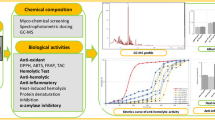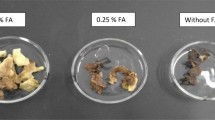Abstract
Marine brown algae Turbinaria ornata (T. ornata) that grows along Tamilnadu coast (Gulf of Mannar) were collected to study the composition of major and minor nutrients, phytochemical constituents and to evaluate the cytotoxic effect. Proximate composition of this brown seaweed was investigated by the determination of moisture, ash, protein, lipid and carbohydrate. The mineral content was analyzed using Inductive Coupled Plasma- Mass Spectrometry (ICP-MS). In general, the results of proximate analysis showed that moisture content (83.62%) was most abundant followed by carbohydrate (43.7% dry weight), ash content (23.4%) protein (5.4% dry weight) and lipid (1.9% dry weight). This work presents the data on the mineral content such as manganese, sodium, magnesium, potassium, zinc etc. of the brown algae. The chemical components present in the methanolic extract of the sample were analyzed using Gas Chromatography–Mass Spectrometer (GC-MS). The presence of secondary metabolites illustrate that this brown seaweed T. ornata can be harnessed for their biomedical potentials. Apart from this, the methanolic extract extracted also showed cytotoxic activity against human retinoblastoma Y79 cell lines and the Inhibitory Concentration (IC50) was found to be at 6.37 μg/mL. Further research should be explored for the beneficial application of T. ornata as a potent therapeutic tool against cancer.



Similar content being viewed by others
References
Abramson DH (2005) Retinoblastoma in the 20th century: past success and future challenges the Weisenfeld lecture. Invest Ophthalmol Vis Sci 46:2683–2691
Acremi N, .Cappoen D, Anthonissen R, Verschaeve L, Bouraoui A (2017) Phytochemical and in vitro antimicrobial and genotoxic activity in the brown algae Dictyopteris membranacea. S Afr J Bot 108:308–314
Ahmad F, Sulaiman MR, Saimon W, Yee CF, Matanjun P (2012) Proximate compositions and total phenolic contents of selected edible seaweed from Semporna, Sabah, Malaysia. Borneo Science 31:85–95
AOAC (1997) Official methods of analysis, 16th edn. Association of Official Analytical Chemists, AOAC International, Arlington,VA, USA
Azmat R, Hayat A, Khanum T, Talat R, Uddin F (2006) The inhabitation of bean plant metabolism by cd metal and atrazine III: effects of seaweed Codium iyengaria on metal, herbicide toxicity and rhizosphere of the soil. Biotechnol 5:85–89
Black WAP (1948) The seasonal variation in chemical composition of some of the littoral seaweeds common to Scotland. Part I. Ascophyllum nodosum. J Soc Chem Ind 67:355–367
Black WAP (1949) Seasonal variation in chemical composition of some of the littoral seaweeds common to Scotland. Part II. Fucus serratus, Fucus Vesiculosus. Fucus spiralis and pelvetia canaliculata. J Soc Chem Ind 68:183–189
Blunden G (1993) Marine algae as sources of biologically active compounds. Interdiscip Sci Rev 18:73–80
Boo HG, Hyun JH, Kim SC, Kang JI, Kim MK, Kim SY, Cho H, Yoo ES, Kang HK (2011) Fucoidan from Undaria pinnatifida induces apoptosis in A549 human lung carcinoma cells. Phytother Res 25:1082–1086
Burtin P (2003) Nutritional value of seaweeds. Elec J Env Agricult Food Chem 2:498–503
Chakraborty K, Paulraj R (2010) Sesquiterpenoids with free radical scavenging properties from marine macroalga Ulvafasciata delile. Food Chem 122:31–41
Chakraborty S, Santra SC (2008) Biochemical composition of eight benthic algae collected from Sunderban. Indian J Mar Sci 37:29–332
Chapman VJ, Chapman DJ (1980) Seaweeds and their uses, 3rd edn, Chapman and Hall, Ltd., London, pp 279–312
Chidambaram K and Unny MM (1953) Note on the value of seaweeds as manure. In 1st Int. seaweed Symp 67–68
Critchley AT, Ohno M (eds) (1998) Seaweed resources of the world, Japan International Cooperation Agency, Yokosuka, Japan, pp 429
Cumashi A, Ushakova NA, Preobrazhenskaya ME et al (2007) A comparative study of the anti-inflammatory, anticoagulant, antiangiogenic, and antiadhesive activities of nine different fucoidans from brown seaweeds. Glycobiology 17:541–552
Darcy-Vrillon B (1993) Nutritional aspects of the developing use of marine macroalgae for the human food industry. Int J Food Sci Nutr 44:23–35
De Aragao AP, De Oliveira TM, Quelemes PV, Perfeito MLG, Araujo MC, Santiago JDAS, Da Silva DA (2016) Green synthesis of silver nanoparticles using the seaweed Gracilaria birdiae and their antibacterial activity. Arab J Chem. https://doi.org/10.1016/j.arabjc.2016.04.014
Deepak P, Sowmiya R, Balasubramani G, Perumal P (2017) Phytochemical profiling of Turbinaria ornata and its antioxidant and anti-proliferative effects. J Taibah Univ Med Sci 12:329–337. https://doi.org/10.1016/j.jtumed.2017.02.002
De Quirós ARB, Frecha-Ferreiro S, Vidalpérez AM, López-Hernández J (2010) Antioxidant compounds in edible brown seaweeds. Eur Food Res Technol 231:495–498
El Shafay SM, Ali SS, El-Sheekh MM (2016) Antimicrobial activity of some seaweeds species from Red Sea, against multidrug resistant bacteria. Egypt J Aquat Res 42:65–74
Frías S, Conde JE, Rodríguez MA, Dohnal V, Pérez-Trujillo JP (2002) Metallic content of wines from the Canary Islands (Spain). Application of artificial neural networks to the data analysis. Nahrung 46:370–375
Ghosh T, Chattopadhyay K, Marschall M, Karmakar P, Mandal P, Ray B (2009) Focus on antivirally active sulfated polysaccharides: from structure-activity analysis to clinical evaluation. Glycobiology 19:2–15
Gunasekaran S, Shanmugasokan VKTLS, Pitchai S, Yesudas R, Chacko A (2017) Screening of in vitro cytotoxic activity of brown seaweeds against hepatocellular carcinoma. Journal of Applied Pharmaceutical Science 7:051–055
Harborne JB (1973) Phytochemical methods. Chapman and Hall Ltd, London, pp 49–188
Hedge JE and Hofreiter BT (1962) In: Carbohydrate Chemistry, 17 (Eds. Whistler RL and Be Miller JN), Academic Press, New York, 420
Kelman D, Posner EK, McDermid KJ, Tabandera NK, Wright PR, Wright AD (2012) Antioxidant activity of Hawaiian marine algae. Mar Drugs 10:403–416
Kiratli H, Kocabeyoğlu S, Bilgiç S (2007) Severe pseudo–preseptal cellulitis following sub–Tenon’s carboplatin injection for intraocular retinoblastoma. Journal of AAPOS 11:404–405
Kumar CS, Ganesan P, Suresh PV, Bhaskar N (2008) Seaweeds as a source of nutritionally beneficial compounds-a review. J Food Sci Technol 45:1–13
Liu L, Heinrich M, Myers S, Dworjanyn SA (2012) Towards a better understanding of medicinal uses of the brown seaweed Sargassum in traditional Chinese medicine: a phytochemical and pharmacological review. J Ethnopharmacol 142:591–519
Lowry OH, Rosenbrough NH, Farr AL, Randall RJ (1951) Protein measurements with Folin phenol reagent. J Biol Chem 193:265–275
Maftuch KI, Adam A, Zamzami I (2016) Antibacterial effect of Gracilaria verrucosa bioactive on fish pathogenic bacteria. Egypt J Aquat Res 42:405–410
Manosroi J, Sainakham M, Manosroi W, Manosroi A (2012) Antiproliferative and apoptosis induction activities of extract from Thai medicinal plant recipes selected from MANOSROI II database. J Ethnopharmacol 141:451–459
Marsham S, Scott GW, Tobin ML (2007) Comparison of nutritive chemistry of a range of temperate seaweeds. Food Chem 100:1331–1336
Marudhupandi T, Ajith Kumar TT, Lakshmanasenthil S, Suja G, Vinothkumar T (2015) In vitro anticancer activity of fucoidan from Turbinaria conoides against A549 cell lines. Int J Biol Macromol 72:919–923
Matanjun P, Mohamed S, Mustapha NM, Muhammad K (2009) Nutrient content of tropical edible seaweeds, Eucheuma cottonii, Caulerpa lentillifera and Sargassum polycystum. J Appl Phycol 21:75–80
McDermid KJ, Stuercke B (2003) Nutritional composition of edible Hawaiian seaweeds. J Appl Phycol 15:513–524
Michalak I, Dmytryk A, Smieszek A, Marycz K (2017) Chemical characterization of Enteromorpha prolifera extract obtained by enzyme-assisted extraction and its influence on the metabolic activity of Caco-2. Int J Mol Sci 18. https://doi.org/10.3390/ijms18030479
Naru J, Aggarwal R, Mohanty AK, Singh U, Bansal D, Kakkar N, Agnihotri N (2017) Identification of differentially expressed proteins in retinoblastoma tumors using mass spectrometry-based comparative proteomic approach. J Proteome 159:77–91
Ortiz J, Romero N, Robert P, Araya J, Lopez-Hernández J, Bozzo C, Navarrete E, Osorio A, Rios A (2006) Dietary fiber, amino acid and tocopherol contents of the edible seaweeds Ulva lactuca and Durvillaea antarctica. Food Chem 99:98–104
Portugal TR, Ladines EO, Ardena SS (1983) Nutritive value of some Philippine seaweeds, part 2: proximate amino acid and vitamin composition. Philipp J Nutr 36:166–172
Prince JS, Daly EL (1981) The ecology of Sargassum pteropleuron Grunow (Phaeophyceae, Fucales) in the waters off South Florida. IV. Seasonal variation in manni-Tol, protein, ash and laminaran. Phycologia 20:232–241
Rohani-Ghadikolaei K, Abdulalian E, Ng W-K (2012) Evaluation of the proximate, fatty acid and mineral composition of representative green, brown and red seaweeds from the Persian Gulf of Iran as potential food and feed resources. J Food Sci Technol 49:774–780
Rupérez P (2002) Mineral content of edible marine seaweeds. Food Chem 79:23–26
Śmieszek A, Giezek E, Chrapiec M, Murat M, Mucha A, Michalak I, Marycz K (2017) The Influence of Spirulina platensis Filtrates on Caco-2 Proliferative Activity and Expression of Apoptosis-Related microRNAs and mRNA. Mar Drugs 15. https://doi.org/10.3390/md15080237
Smit AJ (2004) Medicinal and pharmaceutical uses of seaweed natural products: a review. J Appl Phycol 16:245–262
Stella Mary J, Vinotha P, Pradeep AM (2012) Screening for In vitro cytotoxic activity of seaweed, Sargassum sp. against Hep-2 and MCF-7 Cancer cell. Asian Pac J Cancer Prev 13:6073–6076
Thirunavukkarasu R, Pandiyan P, Balaraman D, Subaramaniyan K, Edward Gnana Jothi GE, Manikkam S, Sadaiyappan B (2013) Isolation of bioactive compound from marine seaweeds against fish pathogenic bacteria Vibrio alginolyticus (VA09) and characterisation by FTIR. Journal of Coastal Life Medicine 1:26–33
Trease GE, Evans WC (1989) Pharmacognosy, 13th edn. Balliere Tindall, London, pp176–180
Unnikrishnan PS, Suthindhiran K, Jayasri MA (2014) Inhibitory potential of Turbinaria ornata against key metabolic enzymes linked to diabetes. Biomed Res Int 2014:1–10. https://doi.org/10.1155/2014/783895
Vijayakrishnan R, Shields CL, Ramasubramanian A, Emrich J, Rosenwasser R, Shields JA (2010) Irradiation toxic effects during intra-arterial chemotherapy for retinoblastoma: should we be concerned? Arch Ophthalmol 128:1427–1431
Ye H, Wang K, Zhou C, Liu J, Zeng X (2008) Purification, antitumor and antioxidant activities in vitro of polysaccharides from the brown seaweed Sargassum pallidum. Food Chem 111:428–443
Zak B, Zlatkins A, Boyle (1953) A new method for the determination of serum cholesterol. J Lab Clin Med 14:486–492
Zubia M, Payri CE, Deslandes E, Guezennec J (2003) Chemical composition of attached and drift specimens of Sargassum mangarevense and Turbinaria ornata (Phaeophyta: Fucales) from Tahiti, French Polynesia. Bot Mar 46:562–571
Acknowledgements
The authors are grateful to the management and Centre for Ocean Research, Sathyabama Institute of Science and Technology for providing the support and necessary facilities in carrying out the research activity (ICP-MS & GC-MS).
Author information
Authors and Affiliations
Corresponding author
Ethics declarations
Conflict of Interest
We declare that we have no conflict of interest.
Additional information
Publisher’s Note
Springer Nature remains neutral with regard to jurisdictional claims in published maps and institutional affiliations.
Rights and permissions
About this article
Cite this article
Remya, R.R., Rajasree, S.R.R., Suman, T.Y. et al. Studies on Proximate Composition and Phytochemical Profiling of Turbinaria ornata and its Antiproliferative Effect on Y79 Cell Lines. Thalassas 35, 495–502 (2019). https://doi.org/10.1007/s41208-019-00159-x
Received:
Revised:
Published:
Issue Date:
DOI: https://doi.org/10.1007/s41208-019-00159-x




